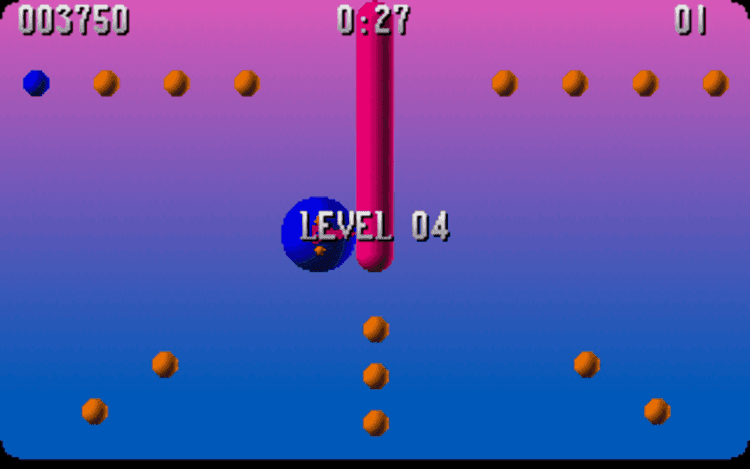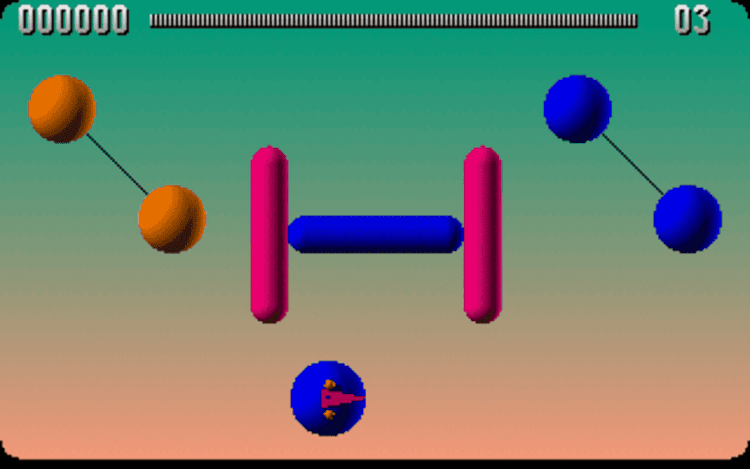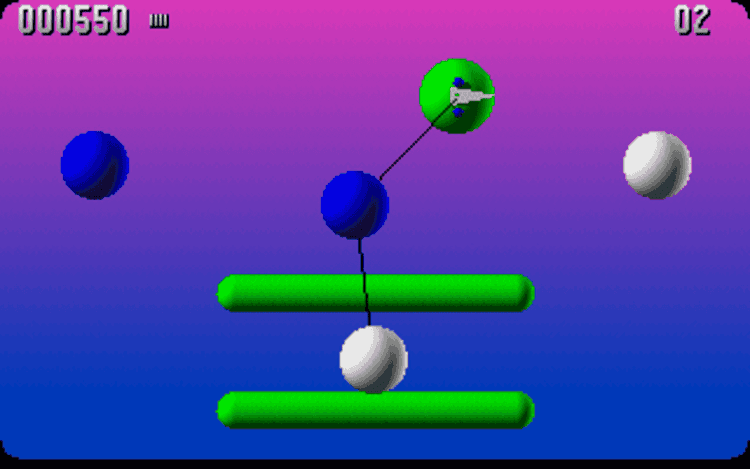
The Game of Harmony is a clever physics-driven puzzle game published by Accolade, inviting you to guide floating spheres until matching colors collide and vanish. Its minimalist look hides deep strategy, rewarding precision, timing, and spatial awareness as each stage reshuffles the rules of motion. If you enjoy the cerebral flow of Oxyd or the chain-reaction satisfaction of The Incredible Machine, this game hits the same sweet spot while feeling distinct. Whether you play online or on original hardware, the challenge remains timeless: manage momentum, master the wraparound screen, and solve each puzzle with cool-headed control.
The Game of Harmony is a distinctive puzzle experience published by Accolade and built on a simple premise that blossoms into intricate, brain-tickling scenarios. Known in other regions under alternate titles, it originated with the inventive minds at The Assembly Line, a studio that carved a niche for deceptively deep concepts. What seems at first like a minimalist arcade diversion quickly reveals layers of timing, geometry, and resource management, all powered by a consistent set of physics rules that turn every level into a fresh conundrum.
Each stage places your small craft in a wraparound arena speckled with colored globes. Your goal is to bring identical colors together so they cancel out, thereby clearing the screen. Bump two different colors, however, and you create new hazards, usually in the form of tiny pods that multiply the chaos and sap precious time. The brilliance lies in how movement never feels binary: momentum lingers, rebounds matter, and edges loop, so sending a sphere off one side to reappear on the other becomes a valid tactic. Because every collision is governed by the same rules, mastery arrives not from memorizing tricks but from truly understanding the physical language of the game.
What makes The Game of Harmony age so gracefully is its teaching cadence. Early levels give you room to experiment with gentle speeds and forgiving layouts. Soon, though, you’re juggling multiple clusters, threading narrow gaps, and planning two or three rebounds ahead. There’s no hand-holding tutorial; instead, each puzzle is a silent lesson, showing you how inertia, angle, and timing combine. Failures never feel arbitrary because the rules are transparent. When you miscue a shot and generate extra pods, you instantly see why—and you start plotting a smarter route on your next attempt.
Unlike puzzlers that drown you in power-ups, this game finds elegance in restraint. Your toolkit is modest: movement, nudging, and a keen sense of how objects will ricochet. The tension comes from a strict timer and the way small errors cascade into busy screens. Veterans soon discover meta-strategies—like using the wraparound edges to “teleport” a long arc into a clean collision, or grazing a sphere at just the right angle to bleed momentum without sending it careening. These tiny optimizations feel earned, and that sense of earned mastery is why the game remains compelling long after you grasp the basics.
You can play The Game of Harmony online to relive its classic puzzle flow without barriers. It runs smoothly in a modern browser, and its clean visuals and simple inputs translate naturally to mobile devices, where touch or virtual controls handle quick nudges and careful lining up of shots. The experience is free, universal, and unrestricted, preserving the challenge while making it easy to jump in for a level or two whenever you have a spare moment. Because the design is focused on physics and timing rather than heavy menus, playing online keeps the emphasis exactly where it belongs: on smart angles and satisfying collisions.
The Game of Harmony sits at a sweet intersection of arcade reflex and cerebral planning. Its visual language is uncluttered, so every element on screen communicates purpose. There’s no ambiguity about objectives, yet there are countless ways to reach them. That combination gives it surprising replay value: even familiar stages can be tackled with new lines and different rhythms. And because the physics are tuned to be consistent rather than punishingly slippery, near-misses feel like lessons instead of luck.
The soundtrack and effects support the action without dominating it, punctuating successful merges and lending urgency as the timer ticks down. It’s understated, but that restraint amplifies focus. Nothing distracts from the geometry you’re building in your head.
If you’re the kind of player who loves mapping a plan in your mind and executing it with a couple of decisive moves, this game will feel like home. It rewards patience, but it also respects momentum; wait too long and the board can turn against you. Players who enjoy the meditative finesse of movement-based puzzlers will appreciate how every input matters. And for those who crave a challenge that’s fair rather than flashy, The Game of Harmony is a model of enduring design.
The Game of Harmony thrives on clarity, consistency, and the thrill of turning a chaotic screen into a solved equation. It’s approachable, yet it carries enough bite to keep experts engaged. Use the keys ‘a’, ‘s’, ‘z”, and the space bar to line up angles instead of overcorrecting with big thrusts. Take advantage of the wraparound field to set up long, low-risk approaches. Keep an eye on the timer, but don’t let it rush you into mismatched collisions that spawn more work. A calm, precise rhythm usually outperforms frantic scrambling.
At its core, this is a puzzle game about balance—between speed and patience, offense and cleanup, bold shots and careful positioning. Master that balance and you’ll find the harmony its title promises.
All used codes are publicly available and the game belongs to its original authors.
Share game
Share game




Share game